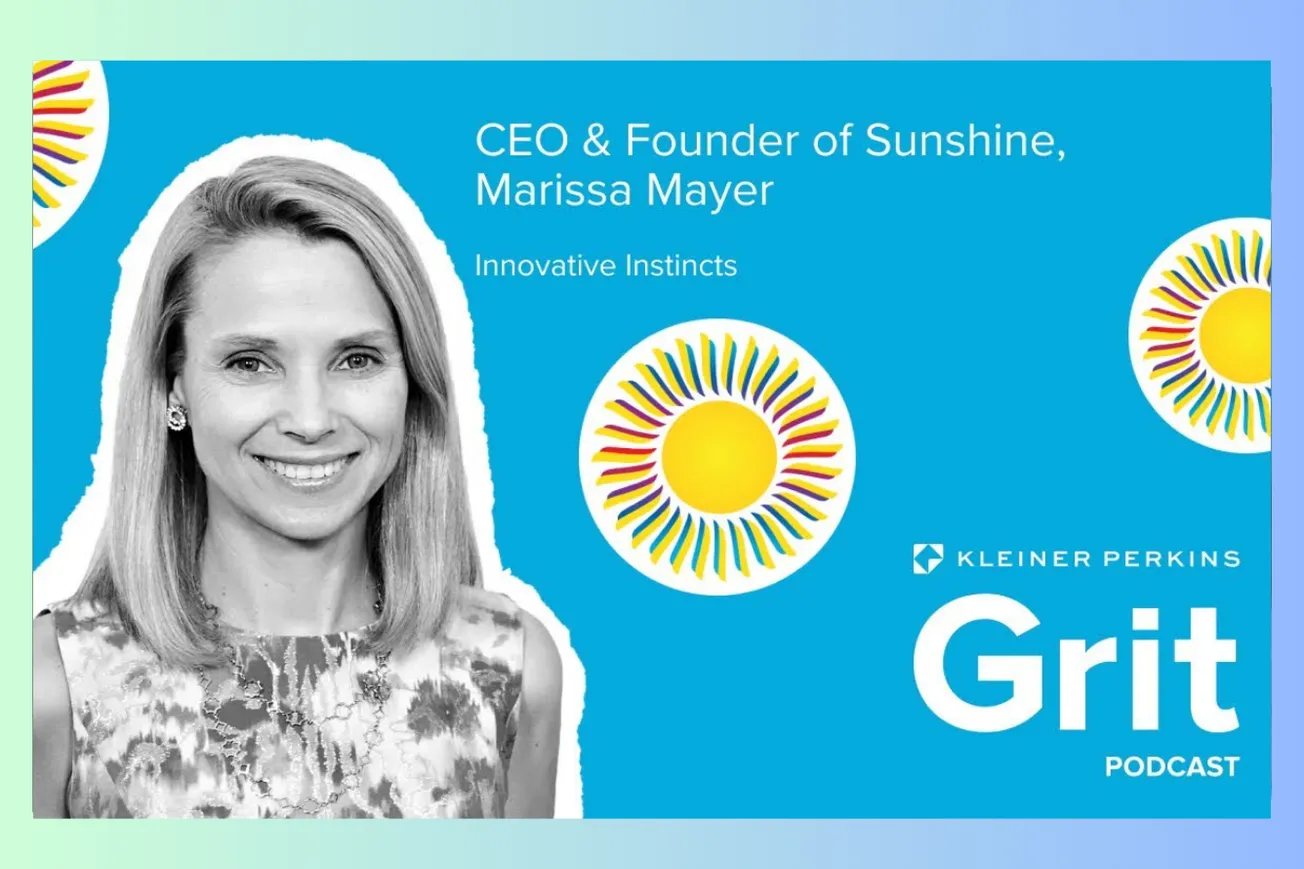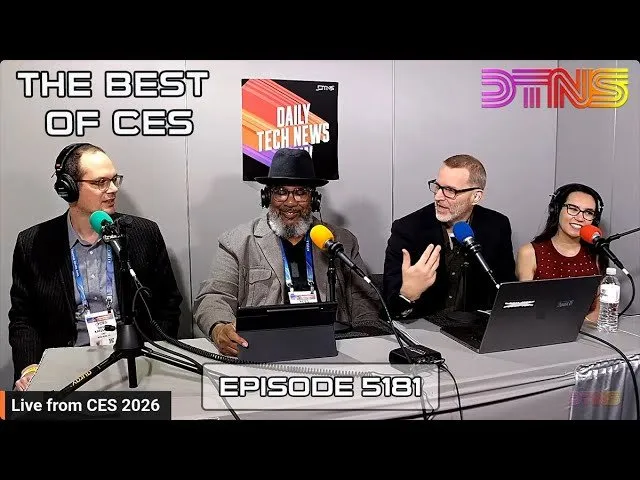Table of Contents
Former Yahoo CEO and Google's first female engineer reveals why she never reads press coverage, how she "inverted" maternity leave to bring her baby to the office, and why working with the smartest people you can find is the key to career success.
Marissa Mayer discusses her journey from Stanford AI student to Google's 20th employee to Yahoo's turnaround CEO, sharing insights on product development, leadership philosophy, and her current mission to make AI more tangible for everyday users through her startup Sunshine.
Key Takeaways
- Marissa has avoided reading press coverage since 2008, believing external editorial opinions can distort internal decision-making and strategic conviction
- She reframes "burnout" as "resentment," arguing that understanding your personal rhythm and non-negotiables prevents workplace frustration better than traditional work-life balance
- As Yahoo CEO, she took just two weeks of maternity leave, creating a "mother's room" in her office to continue breastfeeding while managing the company
- The "Larry and Sergey Bucks" hiring system at early Google forced extreme selectivity, using fake currency to limit company-wide hiring to just 50 people per year
- Yahoo's stock nearly doubled in her first year, though some appreciation came from the hidden Alibaba asset value rather than operational improvements alone
- The Tumblr acquisition for $1.1 billion was competitive with Facebook, but Yahoo struggled with monetization execution as the platform's content became less mainstream
- Marissa's career philosophy involves always working with the smartest people available and taking on roles that feel slightly uncomfortable or beyond current capabilities
- Her startup Sunshine focuses on making AI tangible for non-technical users through everyday tasks like contact management and photo sharing
Timeline Overview
- 00:52–04:55 — Reading Your Own Press: Why Marissa stopped consuming media coverage in 2008, the dangers of external editorial influence on decision-making, and maintaining internal conviction despite public criticism
- 04:55–07:19 — Marissa's Lucky Number 12: The significance of May 12th from childhood achievements, mathematical preferences for divisible numbers, and how coincidences like signing her Google offer reinforced the pattern
- 07:19–15:03 — Sunshine Startup Mission: Building consumer technology that makes AI tangible for everyday users, focusing on overlooked areas like events and groups, and solving persistent problems like messy contact management
- 15:03–21:46 — Burnout, Resentment, and Personal Rhythm: Redefining burnout as resentment rather than exhaustion, the importance of protecting individual non-negotiables like soccer games or Tuesday night dinners, and adapting rhythm to life changes
- 21:46–27:00 — The Yahoo CEO Opportunity: The secretive interview process during pregnancy, approaching leadership as a design problem, and weighing unprecedented challenges against potential impact and learning
- 27:00–31:14 — Inverting Maternity Leave: Creating a windowless office nursery to continue breastfeeding, navigating SEC regulations around CEO disability leave, and choosing work-life integration over traditional separation
- 31:14–36:44 — The Epic Board Interview: Project Cardinal's secretive black car process, 30-40 hours of product preparation, presenting the mobile-first thesis that seemed obvious later but was revolutionary in 2012
- 36:44–42:51 — Dinner Party Drama: The night of board deliberation spent at Lori Puccinelli Stern's dinner party, sitting next to Joe Montana while anxiously waiting for the CEO decision, and maintaining phone discipline during dinner
- 42:51–47:18 — The Life-Changing Voicemail: Jim Citrin's dramatic pause-filled message offering the Yahoo CEO role, the immediate transition from Google to Yahoo negotiations, and the whirlwind 24-hour decision timeline
- 47:18–50:25 — Final Conversations: Speaking with Farzad "Zod" Nazem about Yahoo's technical state, David Filo's pizza visit three blocks away, and securing board support for necessary team changes and compensation
- 50:25–53:52 — Last Day at Google: Leaving without counteroffers, having assistant pack the office while conducting Yahoo interviews, and announcing the pregnancy the same evening as the CEO announcement
- 53:52–59:03 — "Is It Go Time?" Culture Reset: Misunderstanding employee enthusiasm as resignation threats, 24% workforce turnover in six months, hiring back "boomerang" employees, and establishing new leadership momentum
- 59:03–64:46 — The Tumblr Acquisition: Competing with Mark Zuckerberg's last-minute intervention, David Karp avoiding Facebook meetings, Taylor Swift's major presence on the platform, and execution challenges with monetization strategy
- 64:46–66:24 — Alibaba Asset and Verizon Sale: The tax-free spin-off complications, separating core business from Alibaba investment, and designing the optimal structure for shareholder value while maintaining operational independence
- 66:24–71:05 — Larry and Sergey Bucks System: Eric Schmidt's hiring constraint innovation, fake currency with serial numbers limiting company growth, creating internal markets for talent allocation, and raising hiring standards
- 71:05–72:59 — Eric Schmidt's Leadership Lessons: The philosophy that "good executives don't get to do things," focusing on path-clearing rather than direct execution, and empowering teams to run toward clear vision
- 72:59–78:36 — Google's Early Culture: Joining as the 20th employee, working with extraordinarily smart people, Larry and Sergey's Fortune 500 ambition with seven employees, and choosing learning over safety
- 78:36–84:32 — Creating the APM Program: Jonathan Rosenberg's hiring challenge, the bet to train inexperienced but brilliant college graduates, hiring future leaders like Brian Rakowski and Brett Taylor before they became successful executives
The Philosophy of Avoiding Press Coverage
Marissa Mayer developed a deliberate strategy of avoiding press coverage starting in 2008, recognizing that external editorial perspectives could undermine internal decision-making conviction. She observed that positive coverage made her less likely to revisit potentially bad decisions, while negative coverage could cause her to abandon potentially good strategies prematurely.
This approach reflects deeper wisdom about leadership psychology and decision-making under public scrutiny. Press coverage necessarily applies editorial judgment about strategic choices, but journalists lack the full context of internal discussions, market dynamics, and operational constraints that inform executive decisions.
The discipline extends beyond just avoiding articles to maintaining focus on core constituencies—team members, customers, and company mission—rather than external interpretation. Marissa allows trusted people to provide "gist" summaries of major themes without consuming the detailed analysis that could introduce bias.
- Press coverage applies editorial judgment without full context of internal decision-making processes
- Positive coverage can reduce willingness to revisit potentially flawed decisions, while negative coverage can undermine good strategies
- External interpretation often lacks understanding of operational constraints and market dynamics that inform strategic choices
- Maintaining focus on team, customers, and mission provides more reliable feedback than media analysis
This philosophy proves particularly valuable for leaders making contrarian or innovative decisions that might not be immediately understood by external observers. The approach requires confidence in internal feedback systems and decision-making processes.
Redefining Burnout as Resentment
Marissa challenges conventional burnout narratives by arguing that exhaustion itself doesn't create lasting workplace dissatisfaction—resentment does. Her theory suggests that people can sustain high work intensity if they understand and protect their personal "rhythm" and non-negotiable priorities.
She illustrates this through examples of team members who thrived under demanding schedules once their individual needs were identified and protected. A soccer mom could handle 1 AM calls with her Bangalore team as long as she never missed her children's 4:30 PM recitals. A college graduate could work intense hours as long as he never missed Tuesday night dinners with roommates.
The key insight involves identifying what specific cancellations or compromises generate lasting resentment rather than temporary disappointment. Once these trigger points are understood, managers can actively protect them, creating sustainable high-performance environments.
- Burnout stems from resentment about unmet personal needs rather than work intensity alone
- Individual "rhythm" requirements vary dramatically between people and life stages
- Protecting specific non-negotiable activities prevents cumulative resentment that destroys motivation
- Managers who understand team members' trigger points can actively prevent burnout through targeted protection
This framework shifts focus from generic work-life balance policies to personalized understanding of individual sustainability factors. The approach requires ongoing communication about changing priorities as life circumstances evolve.
The Inverted Maternity Leave Innovation
Faced with Yahoo's turnaround urgency and her desire to breastfeed her newborn, Marissa created an innovative solution by bringing her baby to work rather than taking traditional leave. She converted a windowless coat closet into a soundproof nursery adjacent to her office, allowing feeding and bonding while maintaining CEO responsibilities.
The arrangement reflected broader challenges around executive maternity leave policies, including SEC regulations that classify such leave as "disability" for public company disclosure purposes. Rather than navigate these complexities, Marissa structured her absence as vacation debt, working while technically using accrued time off.
This "inverted maternity leave" approach allowed her to maintain company momentum during a critical transformation period while preserving the bonding and breastfeeding relationship she prioritized. The solution required significant personal privilege but demonstrated creative problem-solving around traditional work-family trade-offs.
- Traditional maternity leave policies proved incompatible with Yahoo's turnaround timeline and CEO responsibilities
- SEC regulations requiring "disability" classification for CEO maternity leave created additional complexity
- The office nursery solution preserved both bonding priorities and business continuity during critical transformation
- The approach required significant personal privilege while demonstrating innovative thinking about work-life integration
The controversy around this arrangement reflected broader societal tensions about working mother expectations and the intersection of personal choices with public leadership roles.
The Larry and Sergey Bucks Hiring System
Eric Schmidt's early Google innovation addressed rapid growth challenges by creating artificial hiring constraints through a fake currency system. Instead of allowing departments to hire freely, Schmidt printed 50 "Larry and Sergey Bucks" with serial numbers, requiring VPs to trade these certificates to make offers to candidates.
The system forced cross-departmental collaboration as VPs had to negotiate with each other about talent allocation priorities. Engineering might trade hiring capacity to sales in exchange for specific feature development, creating internal markets that optimized company-wide resource allocation.
This constraint mechanism dramatically raised hiring standards while ensuring thoughtful consideration of each new role's necessity and impact. The artificial scarcity prevented the quality dilution that often accompanies rapid scaling, establishing Google's reputation for extremely selective hiring practices.
- Artificial hiring constraints prevented quality dilution during rapid company scaling
- Internal trading markets forced cross-departmental collaboration and resource optimization
- The fake currency system raised hiring standards by requiring explicit justification for each new role
- Creative constraint mechanisms can maintain culture and quality during high-growth periods
The approach demonstrated how thoughtful constraints can improve decision-making quality rather than simply limiting options, creating sustainable growth patterns that maintain organizational effectiveness.
The Tumblr Acquisition Competitive Drama
Yahoo's $1.1 billion Tumblr acquisition involved intense last-minute competition with Facebook as Mark Zuckerberg attempted to intervene after news of the deal leaked. David Karp, Tumblr's founder, literally avoided his apartment and office while texting Marissa about Zuckerberg's attempts to arrange competing meetings.
The acquisition reflected Marissa's strategy to capture mainstream social media assets that could benefit from Yahoo's large existing user base. At the time of purchase, Tumblr hosted major cultural figures like Taylor Swift and maintained more mainstream content than it would later develop.
However, Yahoo's execution of the monetization strategy proved problematic. The company moved too slowly to implement advertising systems, and as Tumblr's content became less mainstream over time, advertiser comfort with the platform decreased significantly.
- The competitive acquisition process involved Facebook's last-minute intervention through direct founder outreach
- Tumblr represented a mainstream social media asset with major cultural figures and broad user engagement
- Yahoo's slow monetization implementation allowed the platform's content to drift away from advertiser-friendly territory
- Execution challenges overshadowed what industry observers considered a strategically sound acquisition
The experience highlighted the importance of rapid integration and monetization implementation when acquiring platforms with evolving user bases and content dynamics.
Building the Google APM Program
Marissa created Google's Associate Product Manager program through a bet with her boss Jonathan Rosenberg, arguing she could train brilliant college graduates faster than the company could hire experienced product managers from other companies. The program emerged from hiring bottlenecks that left engineering teams without adequate product support.
Her strategy involved recruiting from top computer science programs, looking specifically for students who understood both technology and its applications. Rather than seeking traditional product management experience, she prioritized intellectual capacity and the ability to envision technology's practical implications.
The program's success produced numerous future technology leaders, including Brian Rakowski (Chrome and Android), Brett Taylor (Facebook CTO, Salesforce CEO), and Nisha Shaw (Google Education). These leaders developed under Google's high-expectations culture with formal coaching support unusual for new graduates.
- The program addressed hiring bottlenecks by training high-potential graduates rather than competing for experienced talent
- Selection criteria emphasized intellectual capacity and technological vision over traditional product management experience
- Formal coaching and mentoring support accelerated development of future industry leaders
- The approach demonstrated how investment in raw talent can produce superior long-term results compared to external hiring
This innovation influenced industry hiring practices and established pathways for technical talent to develop product leadership capabilities early in their careers.
Decision-Making Philosophy: Seeking Smart People and Discomfort
Marissa's career decisions consistently involved working with the smartest available people while taking on roles that felt slightly uncomfortable or beyond her current capabilities. This pattern emerged from analyzing her best decisions: attending Stanford, changing from pre-med to symbolic systems, internships at SRI and UBS research lab.
At Google, she gave the company only a 2% chance of success but recognized that even failure would provide more learning than success elsewhere. The opportunity to be among the first 20 employees of a potential Fortune 500 company offered unique perspective on high-stakes decision-making processes.
This philosophy prioritizes learning and growth over security, betting that exposure to exceptional people and challenging situations accelerates personal development more than safer alternatives. The approach requires tolerance for uncertainty while maintaining confidence in one's ability to adapt.
- Career decisions consistently prioritized learning opportunities over security or conventional success metrics
- Working with exceptionally smart people accelerates personal development and strategic thinking capabilities
- Choosing slightly uncomfortable roles forces growth and reveals capabilities that might otherwise remain dormant
- Even failure in ambitious environments provides more valuable learning than success in predictable situations
This framework helps explain how someone can transition successfully between very different roles and industries by focusing on fundamental learning rather than domain-specific expertise.
Making AI Tangible Through Everyday Tasks
Sunshine's mission involves making artificial intelligence benefits tangible for non-technical users through improvements to mundane daily activities. Rather than competing in large language model development, Marissa focuses on applications that demonstrate immediate, practical value.
The company's initial focus on contact management addresses a universal problem—approximately 19% of people's address books contain outdated information. By making contacts "dynamic and alive," updating automatically when people move or change preferences, the platform eliminates friction that prevents effective communication.
This approach reflects Marissa's broader philosophy about consumer technology: the most meaningful innovations often address overlooked problems that everyone accepts as unchangeable. Success requires making AI improvements feel natural rather than technological.
- AI adoption requires demonstrating immediate practical value rather than abstract technological capability
- Mundane problems like contact management affect everyone but receive little innovation attention
- Making technology improvements feel natural rather than obviously artificial increases user adoption
- Consumer AI success depends on solving real friction points rather than showcasing technical sophistication
The strategy positions AI as an invisible enhancement to existing workflows rather than a replacement for human activities, potentially reducing resistance while delivering measurable benefits.
Common Questions
Q: Why did Marissa stop reading press coverage about herself and her companies?
A: She realized that external editorial opinions could bias her decision-making, making her less likely to revisit potentially bad decisions when coverage was positive, or abandon potentially good strategies when coverage was negative.
Q: How did the "Larry and Sergey Bucks" system work at early Google?
A: Eric Schmidt created 50 fake currency certificates that VPs needed to "spend" to make hiring offers, forcing departments to trade hiring capacity and creating internal markets that optimized talent allocation across the company.
Q: What was innovative about Marissa's maternity leave arrangement at Yahoo?
A: Instead of taking traditional leave, she created an office nursery in a converted coat closet, allowing her to continue CEO duties while breastfeeding and bonding with her newborn during Yahoo's critical turnaround period.
Q: Why did the Tumblr acquisition struggle despite initial success?
A: Yahoo moved too slowly to implement monetization systems, and as Tumblr's content became less mainstream over time, advertiser comfort with the platform decreased, making revenue generation increasingly difficult.
Q: How did Marissa's career philosophy of "working with smart people" influence her Google decision?
A: She gave Google only a 2% chance of success but recognized that even failure among the first 20 employees of a potential Fortune 500 company would provide more learning than success elsewhere.
Conclusion
Marissa Mayer's career demonstrates how consistent application of learning-focused principles—seeking smart colleagues, embracing discomfort, focusing on user problems—can enable successful transitions between very different roles and industries. Her approach to leadership challenges, from press management to maternity leave innovation, reflects creative problem-solving that prioritizes mission success while maintaining personal values.
Her current work with Sunshine continues this pattern, applying AI capabilities to everyday problems that major technology companies often overlook, potentially creating meaningful value for users who haven't yet experienced tangible AI benefits.





